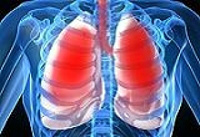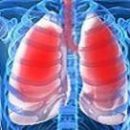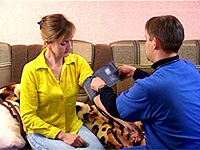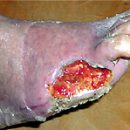What is hemotorax? What are the symptoms of hemotoraks? How to diagnose and treatment of hemotorax? Answers to these questions you will find in the article.
Content
Hemotorax
Hemotorax - blood cluster in pleural cavity. It occurs when impaired integrity or increasing the permeability of the vessels of the lungs, pleura, the walls of the chest, mediastinum. The cause of the traumatic hemotorax - closed or open injury of the chest of various etiologies with damage to the intercostal and inner chest artery, organs (lungs, hearts, diaphragms), intrabriety branches of large vessels (aorta, hollow veins), operational interventions.
Internal bleeding leads to the accumulation of blood in the pleural cavity, squeezing the lung on the side of the lesion, with a possible displacement of the mediastinum. As a result, there is a decrease in the respiratory surface of the lung and aggravation of respiratory disorder and blood circulation. The displacement of the mediastinum with compression of hollow veins and pulmonary vessels in turn has an adverse effect on hemodynamics. The clinic of acute respiratory and heart failure occurs.
Symptoms of hemotorax
The clinic depends on the intensity of internal bleeding, compression or displacement of light and mediastinum. Burnt and deep lung breaks are accompanied by massive bleeding, superficial damage - insignificant. Small hemotorax to 200 ml. In most cases, clinically not recognized. Symptoms comes down to pain in the area of damage and some restriction of respiratory movements. Later is usually absorbed with the formation of pleural battles. With an average hemotorcase, cough, shortness of breath, chest pain, pallor, backlog in the chest breath act from the affected side, breathing impaired and blunting a percussion sound. Radiation diagnostics reveals blackout at the corner level of the blade, sometimes with a horizontal level.
In severe cases, the symptoms of massive intrapharmal bleeding are symptoms: weakness, pallor of skin and mucous membranes, tachycardia, shortness of breath, falling blood pressure, which shares the picture of the main damage. Anxiety, chest pain,, skin cyanosis, swelling of intercostal intervals, cough, sometimes with blood, breathing difficulty, dulling the percussion sound, noticeable lag in the act of breathing chest, perfectly determined by stupid sound, breathing. The degree of anemia depends on the magnitude of blood loss. The victims of the breast injuries, even without objective signs of the penetrating nature, are examined in the sitting position and should be hospitalized.
Diagnosis of hemotorax
The diagnosis is confirmed by the data of the clinic, the infrinal radiography of the chest (X-ray survey) and pleural puncture, thoracoscopy. It is very important to establish the continuing bleeding into the pleural cavity or already stopped. To do this, spend a sample of Ruvilua - Grehuhar. The blood obtained in the syringe is poured into the test tube or tray if the blood is folded, it is a sign of continuing bleeding, if not - bleeding stopped. It is explained by the fact that with the continuing bleeding, anticoagulants produced by the pulmonary fabric and pleura can not cope with the coagulating system of the newly incoming blood and the clots are formed.
The danger of hemotorax is the possibility of infection from damaged lung or bronchi and is extremely important to promptly recognize the complication. Petrova's sample - the resulting point is divorced by distilled water in a ratio of 1: 5. After hemolysis of red blood cells assess the reaction. Hemolyzate is evenly painted and transparent (lacquered blood) - blood is not infected if the muddy suspension (cloud, flakes) is revealed - infected. If there is a pleural cavity at the same time and air and blood, the latter forms a horizontal level. In this case, the diagnosis of hemopneumothorax.
Treatment of hemotorax
 The victims with the hemotorax should be immediately sent to the hospital for the execution of pleural puncture. The puncture of the pleural cavity in the hemotorcase is made in 6-7 intercostrine between the middle and posterior lines (in the sitting position) or closer to the rear axillary line (in the lying position) with strict observance of the asepta rules. The blood from the pleural cavity is completely removed and the antibiotics of a wide range of action are introduced. Great features of modern multidisciplinary medical institutions predetermine the use of clear diagnostic and tactical programs. Solving tactic selection issues depends on the specific conditions for the provision of qualified assistance. General treatment: hemostatic, disaggregative, immunocorrorizing, symptomatic therapy, general and local antibiotic therapy for the prevention and treatment of infection, the introduction of fibrinolytic drugs for the prevention and treatment of a culbble hemotorax.
The victims with the hemotorax should be immediately sent to the hospital for the execution of pleural puncture. The puncture of the pleural cavity in the hemotorcase is made in 6-7 intercostrine between the middle and posterior lines (in the sitting position) or closer to the rear axillary line (in the lying position) with strict observance of the asepta rules. The blood from the pleural cavity is completely removed and the antibiotics of a wide range of action are introduced. Great features of modern multidisciplinary medical institutions predetermine the use of clear diagnostic and tactical programs. Solving tactic selection issues depends on the specific conditions for the provision of qualified assistance. General treatment: hemostatic, disaggregative, immunocorrorizing, symptomatic therapy, general and local antibiotic therapy for the prevention and treatment of infection, the introduction of fibrinolytic drugs for the prevention and treatment of a culbble hemotorax.
Indication for surgical treatment - continued bleeding, re-accumulation of blood after aspiration, blood release through drainage in a volume of more than 5-3 hours in 2-3 hours, rolled up a large hemotorax that prevents light resgrade, damage to vital organs. It is preferable to start with video color interventions as a safe method of diagnosis and treatment with thoracic injury. Indications for thoracoscopy: wound injury, complicated by gem and pneumothorax, suspected of the injury of pericardium, heart, breast wall vessels, and thoracoabdominal wounds. With low localization of breast wounds on the left in order to identify the state of the diaphragm, the mandatory use of thoracoscopy is recommended.
The testimony to the thoracotomy are: the wound of the heart, suspected of the injury of the heart or a large vessel, damage to large bronchi or esophagus, continuing intrapharmal bleeding, tense pneumothorax, not eliminated by punctures and drainage, wounding the breast lymphatic duct, the ingredients of the pleural cavity. The diagnosis of rolled hemotorax is established due to the clinic (shortness of breath, pain, fever) and a typical x-ray pattern (the presence of homogeneous and intensive darkening on the side of the lesion of the lower sections of the pulmonary field or a non-dimensional dimming with fluid levels). Thoracotomy and removal of curved hemotorax, made in the first 5 days, warn the development of the speech of the pleura, contribute to the most adequate restoration of lung functional abilities.









